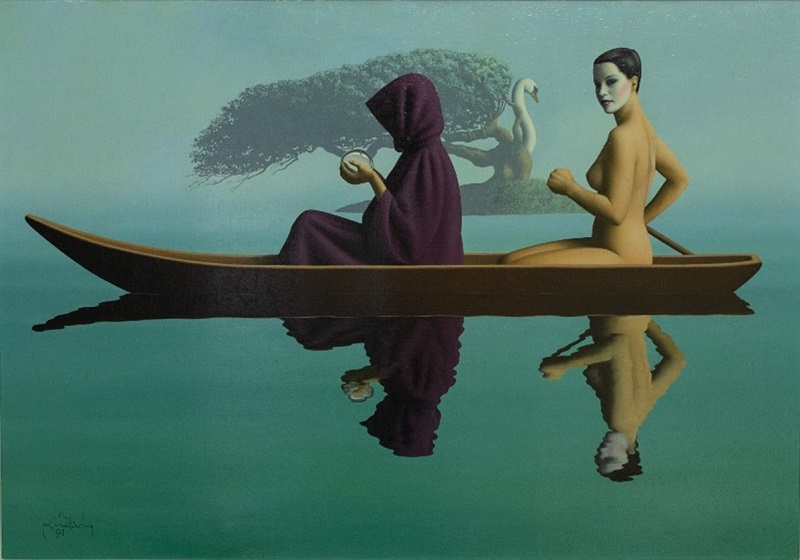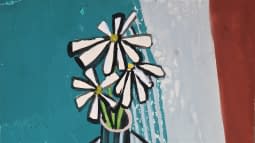The Encounter with Art: Werner Häberling - an Artist from Zurich and Master of Fantastic Realism
Note: The photo of the artist in the blog title picture is a special rarity. The Swiss painter was reluctant to be photographed. It shows him at one of his openings.

Fig. 1: Werner Häberling, The Boat (org. Das Boot), 76 x 100 cm.
In the painting "The Boat" from 1992, you see water, a boat with two people and an island. Something quite ordinary that can be seen on most bodies of water. Viewed in detail, however, a few things stand out. The water is calm, almost as smooth as glass. The boat is a simple canoe carved from one trunk. The boat driver is naked and wearing make-up, while the passenger is veiled. The passenger is carrying a crystal ball. The way he holds it and looks down on it, it seems to be very valuable. On the small island there is a tree or a large bush and the neck of a swan. The air seems hazy, for the transition from water to air is blurred.
What is the reason for the crossing? Who is the naked woman? Why is the passenger veiled? Why the island and the swan or swan tree? What is the reason for the journey? Is the globe meant to show the way or is it simply valuable to the passenger? Could the boatwoman be a nymph who helps the human?
Nymphs are often scarcely dressed or naked as here. The boatwoman is said to be a nymph. She seems to know exactly what she is doing, so the assumption is that the orb she is holding is not showing the way, but is simply very precious to the passenger - so precious that it must be constantly watched. For waters can be dangerous, tranquillity can be deceptive. The nymph was certainly careful enough to protect herself, the passenger and his treasure. So, she asked Nestis, the Sicilian goddess of water, to leave her underworld and protect the canoe and its passengers. Nestis, mistress of the element of water, takes on the pure form of a swan and thus shows the nymph that she has complied with her request. The nymph's face shows an incredible calm and serenity because she knows that nothing can happen to them. Unfortunately, the human being in his frock is not aware of this security and fixates on his supposedly precious possession, fearful and unable to perceive the environment, to enjoy the canoe trip, unable to get to know the friendly and beautiful nymph better, to have a dialogue, to live serenity and trust.
How often does this happen to us in life? With so much thinking and worrying, we often forget to live life, to live and enjoy the moment, to allow the thought and worry about the future to paralyse and blind us, to miss that there is only the lived moment - yesterday is over, the future does not exist.

Fig. 2: Werner Häberling, Hot Lips, 50 x 88 cm.
Häberling's second work "Hot Lips" from 2002 makes us think of Africa: Imposing landscapes, the most beautiful wild animals on earth, endless expanses, plains, desert, jungle, poverty, hunger, war, misery, slums, poachers. Longing for the beautiful, distance from the terrible. These are often the first associations we make when we think of Africa. But we forget the real Africa, we forget the beauty of the people, their special way and their joy of life. The painted woman shows us many interesting things. She shows pride, joie de vivre, inner peace and a great beauty.
Would it be the same beauty without these attributes? Can one be beautiful if one has no joy and is constantly worried, and may even be envious and begrudging? It doesn't need daylight. Everything comes from within, from the mind, the soul, the attitude. A glow from within, a positive aura. How much does a lady's hat of the English establishment cost? Half a fortune or a whole fortune, at least from Africa's point of view. This woman winds a scarf around her head, and it is hardly possible to be more elegant and beautiful. The mischievousness in her eyes and the great satisfaction challenge many.
How is that possible? Perhaps she does not own a solidly built house, and the luxury car could also be missing. However, she has demands on her appearance, her eyebrows are precisely groomed and her eyes are somewhat made up, which further emphasises her aura of self-confidence and contentment. We do not know what the woman owns or under what circumstances she lives. We see a night sky and a tree, probably a camel thorn, and we see the sunset reflected in a cloud, not in the woman's mouth.
Werner Häberling's paintings testify to a lust for the undefined, the enigmatic and the mysterious. They are ciphers of the unconscious and the archetypal. In these realms he seeks to discover, to bring this world closer to the viewer and to stimulate the imagination.
Through his craftsmanship and perfection, he succeeds in fascinating the viewer at once. Realistic dream worlds, bizarre illusory worlds that are technically perfectly composed and executed - the art of a visionary dreamer.
Discover more of his magical art here.




